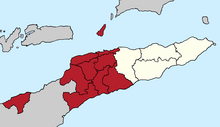Loro Munu

With Loro Munu the western part of the country is East Timor's called. In the past, the name was used for the western part of the island of Timor , as Loro Munu means setting sun or simply west . The residents of Loro Munu are called Kaladi regardless of their ethnic affiliation . In contrast, the eastern part of the country Loro Sae and its inhabitants are called Firaku . The state capital Dili , as a melting pot of the country's various ethnic groups and groups, is the scene of regular street fights between gangs from the east and the west.
The name Kaladi for the western East Timorese is probably derived from the Portuguese calado (quiet, quiet). Governor Luís Augusto de Almeida Macedo reports in his diary how Chinese traders sold banned goods, possibly weapons, to Callady in the mountains. His successor Afonso de Castro calls the language of the inhabitants in the mountains around Dili Calado . The residents of Loro Munu were said to be a little "slow and calm" and far less rebellious than Loro Sae. Another theory suggests that Kaladi was a self-name of the Mambai , which was later adopted in the Tetum as the name of all inhabitants of the mountains in central Timor.
Loro Munu consists of the municipalities of Dili , Aileu , Ainaro , Manufahi , Ermera , Bobonaro , Cova Lima , Liquiçá and the Oe-Cusse Ambeno Special Administrative Region . Sometimes the municipality of Manatuto is also still counted to the west.
The unrest of 2006 , despite the strong national movement from which the country emerged, re-emerged the division of the country into the east and west, which already existed before the colonial era and which has a significant impact on everyday life in East Timor. The center of the island of Timor was ruled on both sides of today's border by the empire Wehale and its center laran . There were only loose ties with the East. Possibly the Osten Wehale also had to pay tribute. When the island was finally divided between Portugal and the Netherlands , Wehale's power collapsed. While Laran took the side of the Netherlands, several rulers previously dependent on him decided to form an alliance with the Portuguese. These areas now formed the colony of Portuguese Timor with the eastern areas .
If there were always internal disputes, it was mostly short tribal wars instead of protracted conflicts. The separation into East and West was of subordinate importance and was mostly masked by political interests. In the civil war of 1975, for example, the front between FRETILIN and UDT cut across regions and ethnic groups. But as early as 1975 the FRETILIN politician Mau Lear warned in his treatise “The establishment of new relationships in East Timor” of the tensions between the two parts of East Timor. After the liberation from the Indonesian occupation, a clear dividing line developed from the weak division. The Firaku claim to have done most of the resistance against the Indonesians.
The Firaku accuse the Kaladi of sympathizing with the occupiers during the Indonesian occupation. Many of the policemen who recruited the Indonesians were Kaladi. The UN and the independent East Timor have taken over most of these police officers into their service. The simmering conflict between the police and the military , dominated by Firaku, results from this.

Today one also notices a political division of the country. In the east, the left-wing, old independence party FRETILIN still dominates , while in the west the ruling Congresso Nacional da Reconstrução Timorense is in the lead.
Web links
- Rethinking Timorese Identity as a Peacebuilding Strategy: Lorosa'e-Loromonu Conflict from a traditional perspective, 6 June 2007 (1.4 MB PDF file)
See also
- History of East Timor
- Chapter languages and ethnic groups in the article East Timor
- Gangs in East Timor
Individual evidence
- ↑ Douglas Kammen: Subordinating Timor - Central authority and the origins of communal identities in East Timor , p. 250 ( Memento of the original from March 5, 2016 in the Internet Archive ) Info: The archive link was inserted automatically and has not yet been checked. Please check the original and archive link according to the instructions and then remove this notice.
- ^ António Benedito 'Nito' da Silva, Community Development Studies, Universidade National Timor-Lorosae: Community and the current crisis in Timor-Leste ( Memento of March 17, 2012 in the Internet Archive )
- ↑ Return to Rai Ketak, Thoughts on "crize"
